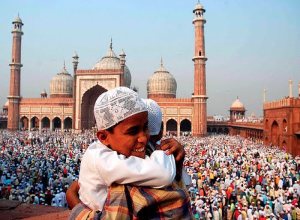What is Eid-ul-Fitr?
The arabic name Eid al-Fitr means 'festival of the breaking of the fast' in English. It marks the end of the month-long fast of Ramadan, and the beginning of the Islamic month of Shawwal. Like other festivals observed by the Muslim community, this festival symbolizes faith.
When is Eid-ul-Fitr?
Ramadan ends with the festival of Eid al-Fitr, which can be on July 18 or 19 2015. Eid al-Fitr is one of the two most important Islamic celebrations (the other occurs after the Hajj, or pilgrimage to Mecca).
How is Eid-ul-Fitr celebrated?
Eid is celebrated on the first date of Shawwal, that is, the tenth month of the Hijra calendar. During the festival, Muslims exchange gifts, greeting their neighbours as a mark of solidarity and brotherhood.
According to the Islamic tradition, there are two festivals observed by Muslims every year - Eid-ul-Fitr just after Ramzan and Eid-ul-Zuha in the month of Haj.
Ramzan, the month of fasting, symbolizes a lot practices and beliefs of the community. It is not merely restraining oneself from having food but also to abstain from all kinds of evil and unlawful practices in Islam.
Muslims, just before the celebrations of Eid-ul-Fitr, keep a month long fast throughout the month of Ramzan. The practice of fasting is also known as 'roza' that starts from the break of dawn till dusk and during this whole day an individual has to refrain hinself from drinking, eating or having sexual intercourse. The term 'roza' us an Arabic word means abstinence. This year Eid-ul-Fitr will be celebrated on August 20 to mark the end of Ramzan, the Islamic holy month of fasting.
The month long fasting ends with the festival of Eid-ul-Fitr that symbolizes a reward for their fasting.
Muslims on this day wear their best clothers and offer 'namaz' a congregational prayer at masjids or mosques. After offering their prayers they exchange good wishes of the festival with their neighbours and other people. They also donate alms to the poor on the auspicios occasion.
The celebration of Eid-ul-Fitr not only has religious essence but also carries a social connotation.
Like other festivals, Eid-ul-Fitr is also observed with great enthusiasm. Delicious food and drinks are an indispensable part of the festivity. People decoare their houses and prepare luscious traditional sweets and cuisines to celebrate the festival. The most common recipe in this festival is the delicious meethi seviyan (Sweet Vermicelli) prepared from various healthy and mouth-watering ingredients.
The celebration of Eid-ul-Fitr is no-doubt perks up the spirit inherent in all the festivity. The significance of this festival is also interpreted as a good time to bring people together in harmony and gratitude.
Method for performing the Eid-ul-Fitr Prayer
The method is to make intention for Eid-ul-Fitr or Eid-ud-Duha for two Rakats Wajib and then lift your hands up to your ears and say ‘Allahu Akbar’ and then fold them below the navel as normal.
Now pray ‘Sana’ and then say Allahu Akbar and lift your hands up to your ears and release them and again lift your hands and say Allahu Akbar and release them again and then lift your hands again and say Allahu Akbar and then fold them.
This means fold your hands after the first and fourth Takbeer and in the second and third Takbeers release your hands. The best way to remember is that if the Imam shall recite after the Takbeer then fold your hands and when he shall not recite (after a Takbeer) release your hands and hang them on the side.
After folding your hands after the fourth Takbeer the Imam will silently recite ‘A’udhubillah’ and ‘Bismillah’ and then he will pray Surah al-Fatiha (‘Alhamd Sharif’) and a Surat loudly and then go into Ruku and Sijdah and (thus,) complete one Rak’at (unit).
Then in the second Rak’at the Imam will first pray the Alhamdu and a Surat then lift your hands to your ears and say Allahu Akbar and release them; and do not fold them and repeat this twice. Therefore a total of three times the Takbeer shall be said. On the fourth time say Allahu Akbar and without lifting your hands go into Ruku.
This therefore means that in the Eid prayer there are six extra Takbeers; three before Qira’at (recitation) and after Takbeer-e-Tahrima in the first Rak’at and three after Qira’at in the second Rakat and before the Takbeer for Ruku.
Also in all the extra Takbeers you must lift your hands and between two Takbeers a gap of three Tasbeehs should be made and it is Mustahab in the Eid prayer to recite after Alhamdu, ‘Surah al-Jumu’ah’ in the first Rak’at and ‘Surah al-Munafiqun’ in the second or in the first pray ‘Sabbih Isma Rabbik al-A’la’ and in the second ‘Hal Ataaka Hadeethul Ghasihiyah’. [al-Durr al-Mukhtar Pgs. 113-114, Bahar-e-Shari’at]
Method of performing the Eid prayer has been taken from the English version of the book “Qanoon-e-Shari’at”, by ‘Allama Shamsul ‘Ulama Shamsuddin Ahmed al-Radawi, the student of Sadr al-Shari’ah, Allama Mufti Amjad ‘Ali al-‘A’azmi.


















